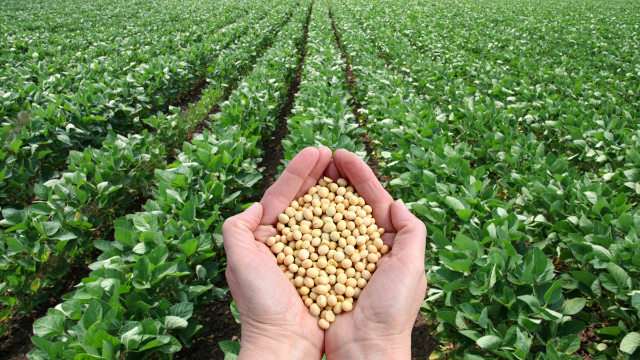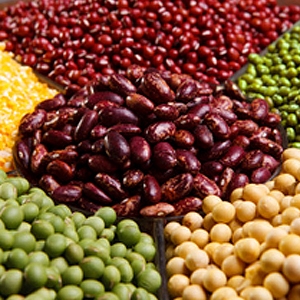We’ve already introduced you to some great sources of veggie protein. But there are more foods you’ll want to get to know as the inevitable shift from meat to plants progresses. Some of these foods are already common in the mainstream…
 Soy Beans: One in the hand is worth two (million) on the bush…
Soy Beans: One in the hand is worth two (million) on the bush…
It is inevitable. Traditional meat is becoming less and less sustainable, both environmentally and economically. I’ve predicted that ‘real’ meat will either become a boutique specialty or disappear altogether as climate change squeezes global agriculture into brave new shapes.
You can access a zillion recipe ideas for any of the foods we’re looking at today, just by Googling its name!
Given that we will all be eating plant protein, predominantly if not exclusively, you might well be asking exactly…
What will we be eating?
Peas, beans and lentils
These protein-rich foods have been cornerstones of Asian and Middle Eastern diets for thousands of years. (See photo, top of page.) And they are not only healthy but versatile and simple to prepare.
Beans, peas and lentils, which are all officially included under the ‘legume’ canopy, are naturally gluten-free. Besides protein, these powerhouse veggies deliver: Fibre, B vitamins, vitamin A, magnesium, calcium, potassium, iron and zinc.
Lentils: Come in a variety of colours and flavours. They’re among the most basic and most favoured veggie protein sources in Indian and West African cuisine.
Peas: Fresh or dried, peas have long been used in the west as food for both people and livestock. They’re immortalized in dishes such as British Mushy Peas, Minted Green Peas and Split Pea Soup.
Beans: There are as many bean varieties as there are cuisines that employ them around the world. They’re prepared in a plethora of ways, from simply boiled, to stewed and sauced, to Mexican ‘refried’ chunky purée. They’re often added to – or star in – soups as well as salads. Mung beans are traditionally cultured for bean sprouts.
Chickpeas: They’re hugely popular across the Med region and Asia. And they’re indispensable in several national cuisines. Chick peas are the main ingredient in Hummus.
Soy products
The ubiquitous Soy bean offers a whole pantryful of different foods that have been considered staples in the East for eons. And they’ve relatively recently started to insinuate themselves in the Western diet. Soy has long been recognised as a valuable source of complete dietary protein.
Soy beans: Used widely as animal feed and, in Asia, they find whole cook books full of recipes detail how to bake, roast, stew, boil and curry them. They’re also enjoyed in an array of traditional entrée salads combined with fresh veggies peppers and spices.
Tofu and tempeh: Both fermented forms of soy milk. Tofu – as most westerners know – is a cheesy substance that comes in a variety of consistences from ‘silken’ to firm. Tempeh is a beverage. Powerhouse foods for the vegetarian menu!
Soy Milk: The ‘original’ veggie substitute for cow’s milk. Healthier in some ways, but deficient in some nutrients delivered by traditional Milk. Supplements are available.
Edamame: Fresh soy beans in the pod, which you get from the produce department. They’re beloved as a healthy, anytime snack. And they often appear cooked whole or mashed, served hot or cold, and sprinkled with salt.
Nuts and seeds
As well as providing high grade protein, these foods also deliver a wide variety of vitamins, minerals and other beneficial compounds. And their oils are high in ‘good’ fats and antioxidants, and, therefore, prized as heart healthy.
Among the most-revered nuts are Almonds and Cashews. Walnuts and Hazel Nuts also receive honourable mention.
Grape Seed Oil is a beloved cooking lubricant in certain traditions. Peanut Oil is a popular high-temperature cooking oil used in place of other, less healthy oils. It’s also considered heart-healthy. (Though, technically, the peanut is actually a legume!)
Grains
Most grains provide some protein. But only a few deliver a concentrated dose. And of these, only some deliver a complete dietary protein complex.
Quinoa: A great choice! Quinoa provides a complete dietary protein complex. It’s cheap and available and easy to prepare. And its nutty flavour finds favour with most if not all diners.
Buckwheat: It’s categorized as a ‘pseudocereal’, and can be used in am–many of the same ways as Barley. It, too, delivers a complete dietary protein.
Sorghum: Also known as ‘broomcorn’ and ‘milo’, has been a popular, high-protein livestock feed for a couple of hundred years. It’s also the source of Sorghum Syrup – a popular sweetener in the US south. What many don’t know is, it’s also a valuable source of veggie protein for humans. Sorghum can be used as a direct replacement for rice or quinoa in most recipes.
Wild Rice: Not really rice, but a water-hosted grass. Which explains the confusion of the first Europeans who encountered it and named it ‘rice’. It’s a rich source of protein, vitamins, minerals and other organic compounds. It’s discinctive nutty flavour is sought after by top chefs. Alas… Wild Rice is the most expensive high-protein grain, by far.
My take
The choice is extensive. The flavour and texture variants are full-spectrum. And the ways you can use these veggie proteins are as diverse as the cuisines that embrace them. I’ve resolved to dive into the deep end and explore the world of veggie proteins now, rather than waiting until they’re all that’s available – and I absolutely have to…
~ Maggie J.

